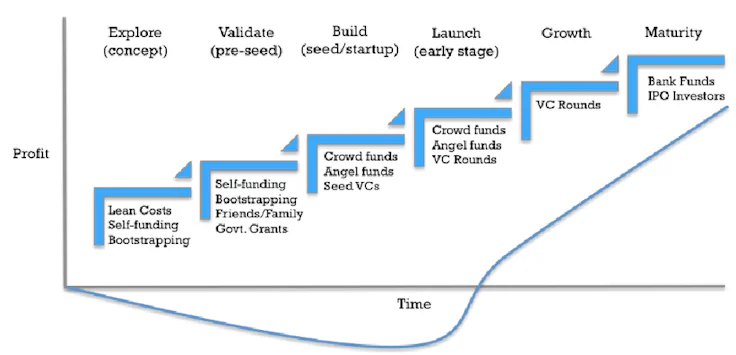

Where Thought Leaders go for Growth


Have you got an ambitious startup? How about a new and innovative idea? You’ve got it! And investors love that.
That works out well because money is the only thing holding you back (for now) from reaching your goals and growing your company to its full potential. Does seeing news announcements of other startups' fundraising make you dream of successfully funding your own company... what if it was finally your turn?
But where do you start? Who can you contact? What are the steps to raise the precious and essential capital needed to make your plans a reality?
We've put together this fundraising guide to help you raise the money you need. From preparing documents to negotiations and even your successful pitch in front of investors, we’ll tell you everything you need to know!
Creating a business plan is an essential requirement to convince investors to support your project by providing funds.
Its objective is to formalize in writing, in a precise, concrete, and structured way, the fact that your company has potential and that it's capable of being profitable and of generating value (that last part particularly interests investors).
This allows them:
In a sense, the business plan is the reflection of your ambition for your company and your ability to achieve set objectives.
What does it consist of? Here are the different parts that must be included:
The executive summary is a short document, generally one to two pages long, which summarizes the key elements of your business plan.
This is the document that you will send to the investors you’re interested in to make them want to meet you. So, you need to successfully interest them in your project and convince them of its seriousness in a concise (but impactful) manner.
Here are the questions it must answer to be sufficiently complete:
Your case is solid and you're ready to present your project to investors! Yes, but who should you pitch your startup to? How do you find people who might be interested in investing in your company?
First of all, depending on the amount of money you need and the stage you’re at, you won’t look for and contact the same type of investor. The diagram below gives you an idea of which funding opportunities exist at each phase of the startup lifecycle:
 ©Alberto Balatti (Wordpress)
©Alberto Balatti (Wordpress)It is common practice in the industry to hire an expert for a fee.
Having a professional fundraiser to assist you can be particularly reassuring if this is your first time, or if you only have a short amount of time to fundraise. In these cases, you might as well delegate!
Their experience and knowledge in the industry can be useful to:
Their fees will cost you varying amounts depending on the scope of your fundraising, often a percentage of the amount raised.
Yes, you need money (badly), but that doesn't mean you should go knocking on just anyone's door.
Raising funds is much more than a simple question of money because the people and organizations that invest in your company will be there with you throughout your journey. In the medium/long term, you will establish a partnership and relationship based on trust.
It is essential to make sure that investors share your ambitions and are the most qualified to help you get the company where you want it to be.
Their field of expertise and their network must be able to benefit you!
These are individuals who invest their personal funds in innovative companies. They are often business leaders who have entrepreneurial experience and may have already successfully sold their company.
This can be a very valuable experience for you, as your angel benefactor will often have a qualified network and valuable advice to share with you on how to make your business prosper. More than their money, they are personally invested in your business.
🤝 Who is it for?
🧐 Where to find them?
The easiest way to find them isn’t in heaven, but by using online websites with networks of business angels. Many such networks exist, such as Angel Investment Network or EBAN which help you connect more easily with investors that want to fund your business.
You can choose your network based on:
📞 How do you contact them?
The process is simple (but finding the right investor can take time). For example, on networking sites like Angel Investment Network, the process looks like this:
You can also do your own research, in your network or via LinkedIn for example. Type "business angel" in the search bar, and you’ll be sure to find plenty of profiles. You will then have to investigate their preferred investment sectors and check if they are used to investing in businesses that are at your stage of development.
Then, if they seem qualified and trustworthy, contact them by sending them your executive summary to spur their curiosity. If they show an interest, you can send them your detailed business plan. If they want to go further, an in-person or virtual meeting could be next!
These structures are distinctive in that they get involved at an early stage in the life of a new startup. You might also see them called Venture Capital, or just VC.
Their objective? To invest as early as possible in companies with very high potential, at a point where the risk is higher, and to work alongside them for 5 to 7 years. The idea is to generate a nice capital gain at the end (and the sooner, the better).
🤝 Who is it for?
🧐 Where to find them?
These investment funds are grouped together again in various online directories which bring together tons of investment structures of all types and in all sectors. Explore directories and find the appropriate funds to contact according to your project (type of investment, amount sought, sector, and geographical area).
📞 How to contact them?
The contact details (website, email, and phone number) are often listed in the directory. All you have to do is consult the information on the website to contact them and learn about the process and terms.
💡 Be aware that some VC funds don’t accept cold outreach. Involving yourself in the community to find someone to refer you to a fund is a huge help!
These structures, also known as growth capital or expansion capital, are designed to provide equity financing to companies that have reached a certain level of maturity. Companies that are still growing and need liquidity to continue their expansion and reach the next level.
Growth capital takes less risk than venture capital. At this stage of funding, startups have already reached profitability and proven their business model. They primarily need money to fuel their growth.
🤝 Who is it for?
🧐 📞 Where to find them and how to contact them?
Just like VCs, you can find these organizations through various online directories that list growth equity firms or funds. Online research for individual firms that focus on investments in your sector and development stage is also a good place to start.
As before, the important contact details (website, email, and phone number) will be either found online, through directories, or even through referrals that you’ve received after involving yourself in the community. You may even be able to directly inquire on the firm's website!
That's right, it's not just investors who ask the questions! This future partnership is a two-way relationship, and you have the right to ask the relevant questions to make sure that the person who is going to buy in is the right one.
Here is a list of questions to ask (future) investors:
What can you bring to my company that will complement your investment (network, experience, industry knowledge, etc.)?
➡️ Ex: If you're a SaaS software company in human resources, having SaaS and HR experts on your team is quite an advantage.
How long does the process take?
➡️ This varies depending on who you're asking for funding. If a single business angel is making the decision, it can go faster than with a network that includes multiple decision-makers and a well-developed process.
What are the next steps in the process?
➡️ If it's not yet clear what the process will look like, don't hesitate to ask. This will help you prepare well before each step to maximize your chances of moving to the next phase with your investor(s).
What are your criteria for investing in a company?
➡️ The answer to this question will allow you to assess your chances of success based on the expectations of a particular investor. Keep in mind that each investor can have different requirements and criteria for investment.
Do you have examples of companies you've invested in? Is it possible to have their contact details to reach out to them?
➡️ In particular, this question allows you to know if you're dealing with active investors or not, how frequently they invest, and what type of companies they’re interested in. If they give you the contact details of business leaders or companies they've worked with, it's a pretty good sign of the quality of their business relationships.
What are your investment possibilities/capacities?
➡️ This is an essential question to avoid wasting your time. If the interest is there, but the investment capabilities can't keep up with your ambitions, consider continuing your search!
What is your position on reinvestment? Do you have a strategy for this?
➡️ It's likely that you will need to raise funds again in a few months or years to continue supporting your development. This question helps to find out how open potential investors are to future collaboration.
A pitch deck is the visual aid you will use during your presentation to investors. It must highlight and support your pitch to investors while giving an overview of your business and its offering. Imagine an executive summary in PowerPoint form.
Since a pitch should not exceed 10 to 15 minutes, your pitch deck should be both concise and convincing enough to spark investors' interest, in about 10 to 15 slides.
Although there isn't an official format for this presentation, here is the primary information that must be presented:
Here are a few simple tips to make your pitch deck successful:
This is perhaps the most crucial moment of your fundraising journey, or at least the one where everything can change. It is the moment when you will make your pitch in front of the investors.
Why an elevator pitch? Imagine that you’re taking the elevator with someone important and you have very little time to catch their attention and convince them.
With investors, it's almost the same thing because they see a lot of startup presentations and hear a lot of pitches, albeit, probably not in the elevator. They don't have much time and, above all, they’re the ones deciding whether to invest or not. So you have to be convincing, in 10 to 15 minutes maximum.
But now that your pitch deck is ready, you’ll have to buckle down and prepare your speech.
The beginning is the most strategic moment of the entire presentation. What's at stake? Grabbing the attention of people who might be in the middle of digesting their afternoon lunch or who might be quickly drifting off into daydreams. That's quite a challenge!
To do this, you'll have to find THE hook. Here are a few examples of techniques that have proven successful:
Investors will have questions at the end of your presentation, that's for sure. Now, which ones will you be asked? That’s harder to predict.
It all depends on what you have provided beforehand. If your business plan is complete enough, and your pitch was clear and convincing, the questions are less likely to be about your market or your product, since everything will have been clear.
Expect more personal questions. Investors need to know that they can trust you, and need to get to know you better before they’ll start working with you. They may try to test your reactions with sensitive questions to see how you react as a business owner.
For example:
Our advice: stay honest and authentic. Don't try to sidestep the issues, as it may show, or exaggerate your strengths. Investors appreciate sincerity, and they know that not everything is a bed of roses.
A letter of intent is the very first formalized document that seriously validates the interest of the investor(s) to bring funds to your company. However, it does not generally constitute a commitment in the legal sense, and the parties can withdraw (while respecting signed clauses). It takes into account the elements that are already negotiated and those which remain to be established.
The drafting and signing of the agreement is the responsibility of the investor, who may be assisted by a legal expert. You will only have to countersign it to express your agreement with its contents. Despite this, it can also be useful to have your own legal counsel review it.
But what is the general information that can be found in it?
Not mandatory (but strongly recommended), due diligence is a set of verifications done by future investors on the company that is raising funds to ensure that the company's situation is healthy at various levels.
The idea is to be able to detect possible fraud, non-compliance, or irregularities that could represent a risk for the investors in the short or long term. That way, they can commit themselves fully, knowing all the facts while avoiding unpleasant surprises.
The strengths and risks of the company are studied at different levels, potentially including:
The investor generally delegates this task to a group of experts who will best be able to evaluate your company.
This due diligence period usually begins after the letter of intent and before the official funding.
The hardest part is done: you managed to convince one or more investors to put some money into your project! 🎉
But don't celebrate too soon, the last step is crucial and by no means the least tedious.
Now you have to reach an agreement on all the terms and conditions of the funding. To maximize the success of this step, you have to find the right balance between the interests of both parties:
If the agreements made respect these interests, then everyone will be a winner. All set? Then we get to move on to the administrative part (what fun!).
You are at the last step, which turns out to be the beginning of a new adventure for the company! "All you need to do" is formalize everything, and you're done. At this stage, having your own legal counsel will help with the specificities to make sure your startup has everything it needs for success.
Here are a couple of key things to make sure to think about:
There you have it, once all the administrative tasks are formalized and completed, you’ll be that much closer to fulfilling your vision of the future for the company. Congratulations! 🎉
Even if we sometimes think the opposite, fundraising isn't the only way to succeed.
Many startups have managed to grow rapidly without raising funds, for example, MailChimp, Shutterstock, Scentsy, GoFundMe, and more.
So don't panic if your fundraising process is not successful: there are different ways to reach the same goal.







![[Case Study] How Appvizer has helped Mailinblack achieve their conversion goals](https://www.datocms-assets.com/17507/1688457000-illustration-appvizer-mailinblack.png?fit=max&fm=webp&q=60&w=227)













